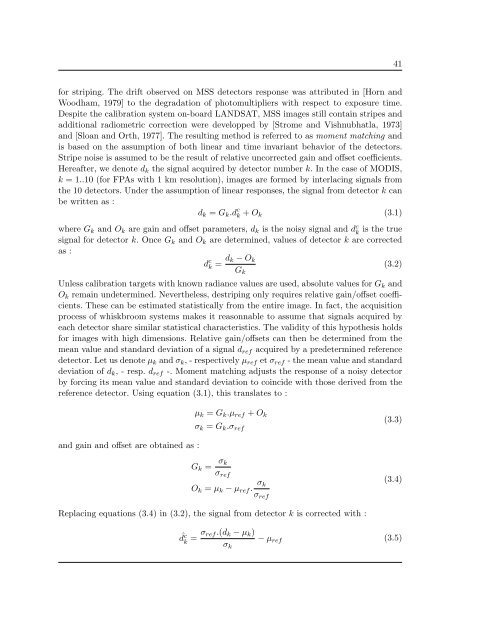Th`ese Marouan BOUALI - Sites personnels de TELECOM ParisTech
Th`ese Marouan BOUALI - Sites personnels de TELECOM ParisTech
Th`ese Marouan BOUALI - Sites personnels de TELECOM ParisTech
You also want an ePaper? Increase the reach of your titles
YUMPU automatically turns print PDFs into web optimized ePapers that Google loves.
41<br />
for striping. The drift observed on MSS <strong>de</strong>tectors response was attributed in [Horn and<br />
Woodham, 1979] to the <strong>de</strong>gradation of photomultipliers with respect to exposure time.<br />
Despite the calibration system on-board LANDSAT, MSS images still contain stripes and<br />
additional radiometric correction were <strong>de</strong>velopped by [Strome and Vishnubhatla, 1973]<br />
and [Sloan and Orth, 1977]. The resulting method is referred to as moment matching and<br />
is based on the assumption of both linear and time invariant behavior of the <strong>de</strong>tectors.<br />
Stripe noise is assumed to be the result of relative uncorrected gain and offset coefficients.<br />
Hereafter, we <strong>de</strong>note d k the signal acquired by <strong>de</strong>tector number k. In the case of MODIS,<br />
k =1..10 (for FPAs with 1 km resolution), images are formed by interlacing signals from<br />
the 10 <strong>de</strong>tectors. Un<strong>de</strong>r the assumption of linear responses, the signal from <strong>de</strong>tector k can<br />
be written as :<br />
d k = G k .d c k + O k (3.1)<br />
where G k and O k are gain and offset parameters, d k is the noisy signal and d c k<br />
is the true<br />
signal for <strong>de</strong>tector k. Once G k and O k are <strong>de</strong>termined, values of <strong>de</strong>tector k are corrected<br />
as :<br />
d c k = d k − O k<br />
(3.2)<br />
G k<br />
Unless calibration targets with known radiance values are used, absolute values for G k and<br />
O k remain un<strong>de</strong>termined. Nevertheless, <strong>de</strong>striping only requires relative gain/offset coefficients.<br />
These can be estimated statistically from the entire image. In fact, the acquisition<br />
process of whiskbroom systems makes it reasonnable to assume that signals acquired by<br />
each <strong>de</strong>tector share similar statistical characteristics. The validity of this hypothesis holds<br />
for images with high dimensions. Relative gain/offsets can then be <strong>de</strong>termined from the<br />
mean value and standard <strong>de</strong>viation of a signal d ref acquired by a pre<strong>de</strong>termined reference<br />
<strong>de</strong>tector. Let us <strong>de</strong>note µ k and σ k , - respectively µ ref et σ ref - the mean value and standard<br />
<strong>de</strong>viation of d k , - resp. d ref -. Moment matching adjusts the response of a noisy <strong>de</strong>tector<br />
by forcing its mean value and standard <strong>de</strong>viation to coinci<strong>de</strong> with those <strong>de</strong>rived from the<br />
reference <strong>de</strong>tector. Using equation (3.1), this translates to :<br />
and gain and offset are obtained as :<br />
µ k = G k .µ ref + O k<br />
σ k = G k .σ ref<br />
(3.3)<br />
G k =<br />
σ k<br />
σ ref<br />
O k = µ k − µ ref . σ k<br />
σ ref<br />
(3.4)<br />
Replacing equations (3.4) in (3.2), the signal from <strong>de</strong>tector k is corrected with :<br />
ˆd c k = σ ref .(d k − µ k )<br />
σ k<br />
− µ ref (3.5)















